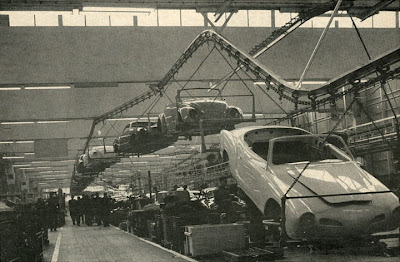Finally got the engine back in today with some help from Jonny, who took time out from a weekend of poker to lend a hand. We started off by killing an hour trying to install a new clutch return spring. The less said about it the better -- suffice to say we learned that prying the hook on the spring around the arm is the very LAST step. We then moved the engine off the inadequate dolly it's been on (note: a Type 1 engine dolly is not a good idea for a Type 3 engine) and onto a motorcycle/ATV jack that I recently bought for the purpose.

I got the motorcycle jack because I wanted something more sturdy and stable than the cheap floor jack I've been using. I waited until the Sears premium jack went on sale -- it's really well made and a bargain for the price. I've heard pros and cons about using a motorcycle jack for a VW engine, and I found it all to be true: It's great to have the engine on a stable, level surface when raising it into position, especially in the tight space of an early Type 3 engine bay, but you also need to be able to tilt the engine as it's going up for clearance, which wasn't so easy with this jack. (We ended up shimming the front with a piece of wood to get the right tilt to clear the clutch at the front and the bodywork at the rear, and then we leveled the engine again once we had it at the right height.) One of the really nice things about the motorcycle jack is its low profile. We only needed to lift the car about 8 inches to slide the engine underneath. Piece of cake. Then we dropped the car back down over the engine and were ready to lift it into position.

We ran into some resistance when pushing the engine into place, which I suspected was the splines on the input shaft not lining up. The trick is to turn the engine slightly with a wrench on the generator pulley while pushing the engine forward. That's when I remembered that I hadn't put the generator belt on yet, so I set about doing it with the engine still on the jack. That wouldn't have been an option with an ordinary floor jack.

The VW Workshop Manual recommends the thin 27mm wrench VW 113 to hold the generator while tightening the nut on the front half of the pulley. I picked one up on eBay a while back and this was my first chance to try it out. Worked like a charm. A slight turn of the engine and a few tiny adjustments to the height of the jack and the engine slipped right into place.


Now I just need some gas and a new 6-volt battery and I should be in business.

































